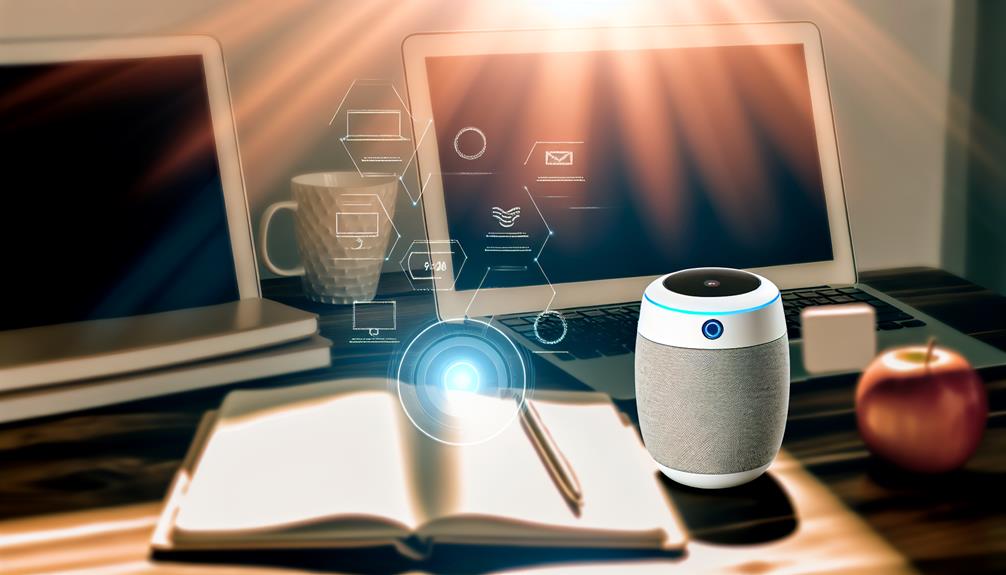Emerging Trends in Productivity Automation Technologies
The landscape of productivity automation technologies is undergoing a transformative shift, characterized by the rise of AI-powered tools and the integration of smart gadgets into everyday workflows. Organizations are increasingly leveraging machine learning for personalized automation, while voice assistants are streamlining task management and enhancing collaboration among remote teams. However, as these innovations advance, they raise critical questions regarding ethical implications, data security, and user adaptability that merit careful consideration. What strategies will organizations adopt to navigate these challenges effectively and maximize the benefits of these emerging technologies?
Key takeaways
- AI-powered tools enhance organizational workflows, driving efficiency while raising important discussions on ethics and user data protection.
- Smart gadgets and IoT solutions streamline processes through automation and interconnectivity, fostering collaboration and increasing productivity.
- Advanced voice assistants enable hands-free task automation and smart scheduling, transforming daily activities into efficient workflows.
- Collaborative tools facilitate remote work, promoting real-time communication and continuous improvement among teams regardless of location.
- Wearable technology improves productivity through real-time data tracking and health monitoring, encouraging well-being and engagement in the workplace.
Rise of AI-Powered Tools
The rise of AI-powered tools represents a transformative shift in productivity automation, reshaping how organizations operate and manage workflows. These tools not only enhance efficiency but also raise critical discussions surrounding AI ethics and user privacy.
As businesses increasingly adopt these technologies, ensuring that user data is protected becomes paramount, fostering trust and encouraging widespread acceptance.
In addition, the accessibility of these tools is crucial for promoting inclusivity within the workforce. Organizations must consider cost implications, as initial investments can be substantial, potentially creating adoption barriers for smaller enterprises.
Addressing these challenges is essential for encouraging a wider embrace of AI-powered solutions.
The workforce impact of AI tools necessitates skill adaptation, requiring employees to evolve alongside technology. Training programs must be implemented to equip staff with the necessary competencies to thrive in this new landscape.
Moreover, the long-term sustainability of innovation hinges on responsible deployment practices, ensuring that advances in productivity do not compromise ethical standards or user privacy.
Integration of Smart Gadgets
The integration of smart gadgets is revolutionizing daily workflow efficiency by enabling greater automation and task management.
With seamless device interconnectivity, users can streamline processes and reduce time spent on routine activities.
This synergy not only enhances productivity but also fosters a more cohesive digital ecosystem.
Enhancing Daily Workflow Efficiency
Numerous organizations are increasingly turning to smart gadgets as a means to enhance daily workflow efficiency. These devices facilitate the implementation of task prioritization strategies, enabling teams to focus on high-impact activities.
By employing workflow mapping techniques, organizations can visualize processes and identify bottlenecks, thereby streamlining operations. Smart gadgets also support productivity metrics analysis, providing real-time data that informs efficiency assessment tools. Such insights empower teams to adopt time blocking methods, allowing for structured time management that enhances focus.
Additionally, goal-setting frameworks integrated into these devices help guarantee alignment with overall objectives, fostering a sense of belonging and shared purpose among team members.
Employing process optimization tips through smart technology can greatly reduce operational redundancies, while focus enhancement methods counteract distractions, leading to improved concentration. Moreover, distraction management techniques facilitate a smoother workflow, allowing employees to perform at their best.
Lastly, smart gadgets promote collaboration enhancement methods, enabling seamless communication and information sharing. By integrating these technologies, organizations not only boost individual productivity but also cultivate a collaborative environment that drives collective success.
Embracing smart gadgets is therefore a pivotal step toward achieving sustained efficiency in today's fast-paced work landscape.
Seamless Device Interconnectivity
Integrating smart gadgets into organizational workflows necessitates a focus on seamless device interconnectivity, which enhances the overall productivity landscape. The integration of smart home technology within business environments emphasizes the need for robust IoT connectivity solutions that guarantee efficient communication between devices.
As organizations increasingly adopt multi-device ecosystems, cross-platform compatibility becomes essential, allowing diverse gadgets to synchronize effortlessly.
However, organizations face device synchronization challenges that can hinder productivity. To address these, innovative user experience design must prioritize seamless data transfer and establish interoperability standards.
Advancements in wireless communication have further enabled organizations to overcome barriers, facilitating automated device management across various platforms.
In this connected era, the ability to integrate smart devices effectively not only optimizes workflows but also fosters a collaborative atmosphere, enhancing the sense of belonging among team members.
By investing in solutions that prioritize seamless interconnectivity, organizations can create a cohesive environment where technology complements human effort, driving overall productivity.
As we move forward, embracing these innovations will be pivotal in shaping a future where organizations thrive through well-integrated smart ecosystems.
Personalization Through Machine Learning
Machine learning is revolutionizing personalization in productivity automation by enabling tailored workflows that adapt to individual user preferences and behaviors.
Through data-driven decision-making, organizations can leverage insights to optimize processes and enhance user engagement.
Additionally, adaptive learning algorithms continually refine these personalized experiences, ensuring that productivity tools evolve in alignment with changing needs and contexts.
Tailored Workflows for Users
Leveraging advanced machine learning algorithms, tailored workflows are increasingly becoming essential in enhancing user productivity and satisfaction. By integrating customized task management solutions, organizations can create highly efficient environments that resonate with individual user preferences. This level of personalization fosters a sense of belonging, as users feel their unique workflows are recognized and valued.
User-centric automation stands at the forefront of this trend, enabling platforms to adapt dynamically to the needs and habits of each user. Through continuous learning and data analysis, these systems can predict user actions and streamline processes, thereby eliminating unnecessary steps and reducing cognitive load. As a result, users experience a more intuitive interaction with their tasks, leading to improved efficiency and engagement.
Moreover, tailored workflows facilitate collaboration by aligning team members' tasks and responsibilities according to their strengths and preferences. This not only enhances productivity but also nurtures a collaborative culture that promotes inclusivity.
In this evolving landscape, the integration of machine learning into tailored workflows represents a significant leap forward, allowing organizations to harness the full potential of their workforce while prioritizing individual user experiences.
Data-Driven Decision Making
Data-driven decision making is revolutionizing the way organizations approach personalization through advanced machine learning techniques. By leveraging data analytics, companies are now able to create informed strategies that cater specifically to their audience's needs. Predictive modeling plays a pivotal role in this transformation, allowing businesses to anticipate trends and tailor their offerings accordingly.
The integration of performance metrics and insight generation empowers organizations to refine their decision frameworks, ensuring that they remain agile and responsive to market dynamics. Additionally, data visualization enhances the comprehension of complex data sets, enabling stakeholders to make strategic decisions grounded in robust statistical analysis.
To illustrate the components of data-driven decision making, consider the following table:
| Component | Description | Impact on Personalization |
|---|---|---|
| Data Analytics | Analyzing large data sets for trends | Enhanced customer insights |
| Predictive Modeling | Anticipating future behaviors | Tailored user experiences |
| Insight Generation | Extracting actionable insights from data | Improved engagement strategies |
| Business Intelligence | Utilizing data for strategic decision-making | Informed product development |
Incorporating these elements fosters a culture of continuous improvement, ensuring organizations can navigate the complexities of personalization effectively.
Adaptive Learning Algorithms
Three key principles underpin the effectiveness of adaptive learning algorithms in personalizing user experiences.
First, dynamic feedback mechanisms are essential in continuously refining user interactions. By analyzing real-time data, these algorithms can adjust content and recommendations, guaranteeing relevance and enhancing user engagement. This responsiveness fosters a sense of belonging, as users feel their unique preferences are acknowledged and catered to.
Second, predictive modeling plays a significant role in anticipating user needs. By leveraging historical data and behavioral patterns, adaptive learning algorithms can forecast what users are likely to find valuable. This proactive approach not only enriches the user experience but also builds a deeper connection between the technology and its users.
Lastly, the integration of user-centered design principles guarantees that these algorithms resonate with diverse audiences. By emphasizing personalization through machine learning, organizations can create environments that feel tailored, inclusive, and engaging.
The convergence of dynamic feedback and predictive modeling within adaptive learning algorithms ultimately cultivates a more empathetic digital landscape, empowering users and fostering loyalty. As productivity automation technologies evolve, the focus on personalization will remain paramount in delivering meaningful experiences.
Voice Assistants in Daily Tasks
As individuals increasingly integrate technology into their daily routines, voice assistants have emerged as pivotal tools for enhancing productivity and streamlining tasks. Leveraging advanced voice recognition technology, these digital assistants facilitate hands-free operation, allowing users to interact seamlessly with their devices. This innovation transforms everyday activities into efficient workflows.
Voice assistants enhance task automation through voice commands, enabling users to manage their schedules, send messages, and set personalized reminders with ease. The growing reliance on smart scheduling features illustrates how these tools not only save time but also improve user interaction by adapting to individual preferences.
| Feature | Benefits | Examples |
|---|---|---|
| Voice Recognition | Effortless user interaction | Siri, Google Assistant |
| Task Automation | Streamlined daily routines | Setting reminders, alarms |
| Smart Scheduling | Enhanced time management | Calendar integration |
Automation in Time Management
How can automation revolutionize the way we manage our time? By integrating advanced tools and technologies, automation enhances our ability to streamline tasks, prioritize effectively, and achieve our goals.
Digital planners, for instance, enable seamless calendar synchronization, allowing users to visualize their commitments and allocate time efficiently.
Time blocking, a method where specific time slots are designated for particular tasks, becomes more manageable with automated reminders and scheduling tools. These tools facilitate task prioritization, ensuring that high-impact activities receive the attention they deserve.
Moreover, automation fosters the implementation of focus strategies, such as the Pomodoro Technique, which encourages sustained concentration by limiting distractions.
Productivity journaling tools can automatically track progress, provide insights, and highlight areas needing improvement, all while supporting goal setting.
Collaborative Tools for Remote Work
Effective collaboration is essential for remote teams to thrive in a digital landscape. As organizations pivot towards flexible work environments, the demand for innovative collaborative tools has surged. Platforms facilitating virtual brainstorming sessions empower team collaboration by fostering creativity, enabling members to share ideas seamlessly regardless of their physical locations.
Effective project management tools enhance remote engagement, guaranteeing that all team members are aligned with project goals. Communication platforms serve as the backbone of interaction, promoting real-time dialogue and reducing the isolation often felt in remote work scenarios.
Additionally, digital whiteboards and workflow synchronization tools allow teams to visualize tasks and guarantee everyone is on the same page. Integrating feedback loops within these platforms cultivates a culture of continuous improvement, where team members can express ideas and concerns openly.
The emphasis on social interaction through these tools helps build camaraderie, while accountability tools guarantee responsibilities are clear, fostering a sense of ownership among team members. As remote work continues to evolve, investing in these collaborative technologies is not just a trend; it is a necessity for cultivating a thriving, connected, and productive workforce.
Data-Driven Decision Making
Which strategies can organizations employ to leverage data for informed decision-making? To thrive in today's competitive landscape, companies must harness data analytics to extract strategic insights. By implementing predictive modeling and performance metrics, organizations can anticipate market trends and enhance operational efficiency. Data visualization plays an essential role in making complex information accessible, enabling teams to grasp key insights quickly.
Investing in business intelligence tools not only supports trend analysis but also strengthens risk assessment methodologies. Effective data governance guarantees that the data utilized is accurate, consistent, and secure, fostering a culture of reliance on data-driven insights. Below is a summary of essential strategies for leveraging data in decision-making:
| Strategy | Description |
|---|---|
| Data Analytics | Analyze historical data for insights |
| Predictive Modeling | Use statistical techniques to forecast |
| Data Visualization | Present data in visual formats |
Future of Wearable Technology
As wearable technology continues to evolve, it is set to transform various sectors, including healthcare, fitness, and personal productivity. The future of wearable devices promises significant advancements in health monitoring, enabling users to track essential signs and overall wellness in real-time.
Enhanced fitness tracking capabilities will encourage user engagement through personalized insights and gamification, fostering a sense of community among users.
Augmented reality (AR) integration will create immersive experiences, allowing individuals to visualize data and interact with their environment in innovative ways.
Smart textiles will revolutionize how we perceive wearable interfaces, embedding technology directly into clothing for seamless interaction and biometric authentication. This shift will not only enhance user experience but also improve stress management through timely feedback on physiological responses.
The interplay of these technologies will cultivate an ecosystem of support, where users feel connected and empowered. As these innovations converge, the potential for wearables to enhance productivity and well-being will be unprecedented, creating a landscape where individuals can thrive in both personal and professional domains.
The future of wearable technology is not just about functionality; it is about fostering a deeper sense of belonging and engagement in an increasingly digital world.
Frequently Asked Questions
What Are the Potential Risks of Productivity Automation Technologies?
Productivity automation technologies pose perilous problems, including job displacement, security vulnerabilities, and data privacy concerns. Furthermore, they risk skill obsolescence and foster technology dependency, necessitating vigilant human oversight to mitigate these challenges effectively.
How Can Small Businesses Benefit From Automation Tools?
Small businesses can greatly enhance workflow efficiency through automation tools, allowing for streamlined processes and reduced manual tasks. This leads to substantial cost savings, enabling reinvestment in growth opportunities and fostering a sense of community within the organization.
What Industries Are Most Affected by Productivity Automation?
Industries such as manufacturing, healthcare, retail, finance, logistics, agriculture, and education are greatly impacted by productivity automation. These sectors experience enhanced efficiency, optimization, and customer service improvements, fostering growth and innovation in an increasingly competitive landscape.
Are There Any Ethical Concerns Regarding AI in Productivity?
While AI enhances productivity, ethical concerns arise, including AI bias, job displacement, and data privacy. Implementing accountability measures and decision transparency within established ethical frameworks is essential to address these challenges and foster trust in automation technologies.
How Can Employees Adapt to Automation in the Workplace?
Employees can adapt to automation by engaging in continuous employee training, fostering workplace resilience. Emphasizing skill development and adaptability cultivates a collaborative environment, enabling teams to thrive amid technological advancements while ensuring a sense of belonging and purpose.



